and the distribution of digital products.
State of XRP Ledger Q3 2024
- In September, Ripple, along with the broader XRP community, announced plans to introduce native smart contracts on the XRPL via an upcoming XLS proposal.
- Average daily transactions increased 94% QoQ to 1.7 million and total new addresses increased 10% to 105,000.
- In August, Ripple announced that its USD-pegged stablecoin RLUSD is in private beta on both the XRPL and Ethereum and pending regulatory approval.
- Following proposals introduced last quarter, a native lending protocol is in development for users to lend and borrow supported assets such as XRP, stablecoins, wBTC, and wETH using single-asset vaults.
- Amendments were passed introducing decentralized identity (DID), which enables verifiable digital identities, and price oracles for pricing wrapped/bridged assets, to the XRP Ledger.
XRP Ledger (XRP) has been running for over a decade, offering cross-currency and cross-border payments, and tokenization, among other features. Core value propositions of the XRP Ledger (XRPL) include fast and cheap transactions (relative to other currency-focused networks) and native functionalities — such as tokens, NFTs, a decentralized exchange (DEX), escrow functionality, embedded compliance, and token management.
With these capabilities, the XRPL can execute many of the same functions as other networks. NFTs, stablecoins, synthetic assets, and other markets found on programmable settlement layers are available on the XRPL as native functionality with composability through enshrined mechanisms such as a central limit order book (CLOB) and automated market maker (AMM). The XRPL base layer doesn't currently support arbitrary smart contracts, which was a deliberate design choice to prioritize security and stability through simplicity. However, the community is actively exploring ways to introduce advanced scripting functionality, such as through solutions like Hooks. Additionally, alternative execution environments, via sidechains, add additional functionality and use cases to the overall ecosystem.
The XRPL is supported by various development groups and individuals, including Ripple, InFTF (formerly XRPL Foundation), XRPL Labs (and Xaman), and XRPL Commons. It provides a digital payment infrastructure not just for individuals but also for existing financial entities, such as commercial banks and fintechs, with the community's deep interest in B2B and B2C solutions for finance. For a full primer on XRP Ledger, refer to our Initiation of Coverage report.
Key Metrics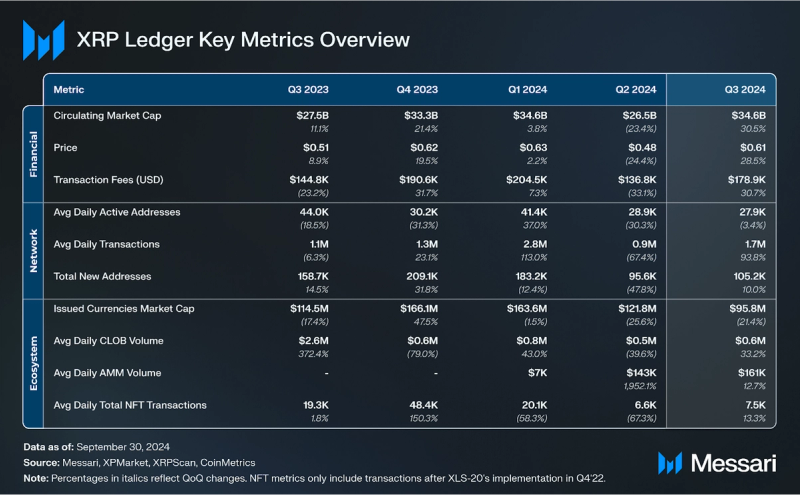 Financial Analysis
Financial Analysis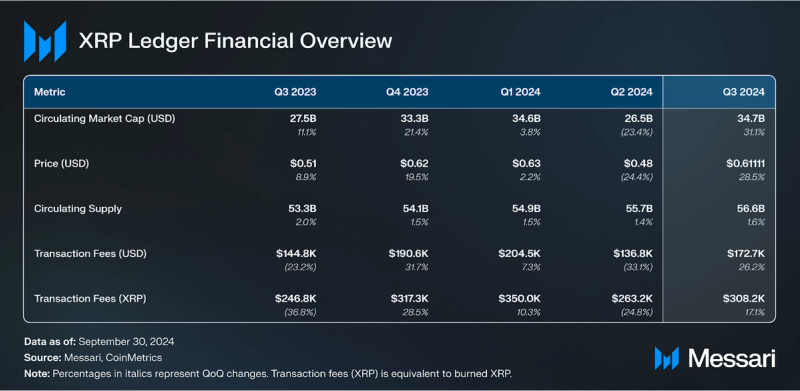
At the close of Q3’24, the XRPL’s native token, XRP, was the seventh largest crypto asset by market capitalization at $34.7 billion. Its circulating market cap increased 31.1% QoQ. XRP’s price increased 28.5% QoQ, with the discrepancy between market cap and price due to a 1.6% increase in circulating supply. Notably, in September asset management firm Grayscale launched its XRP Trust, providing an additional way for accredited investors to gain exposure to the asset. Additionally, in October and November, cryptocurrency exchange-traded fund (ETF) issuers Bitwise, Canary, and 21Shares each completed S-1 filings to launch an XRP ETF.
On XRPL, transaction fees are systematically burned, applying deflationary pressure to the total supply of 100 billion XRP. Since the XRP Ledger’s inception, nearly 13 million XRP ($7.9 million at the close of Q3’24) has been burned. This low burn rate is due to the relatively low transaction fees (<$0.002 per transaction) on the network. Counteracting the burn rate, 1 billion XRP ($610 million at the close of Q3’24) is released from escrow to Ripple per month. Any XRP not spent or distributed by Ripple in that month is put into new escrow contracts. This system will continue until the remaining ~39 billion XRP becomes liquid. After all escrowed tokens become liquid, the deflationary pressure from burned fees will be the only variable related to supply.
Unlike many other cryptocurrency networks, the XRPL does not distribute rewards or transaction fees to its validators. In Proof-of-Association (PoA), rather than receiving rewards, validators are mainly incentivized by supporting the decentralization of the network, similar to a full node for Ethereum/Bitcoin rather than a validator/miner. The PoA consensus algorithm relies on trust between nodes, organized through unique node lists (UNLs).
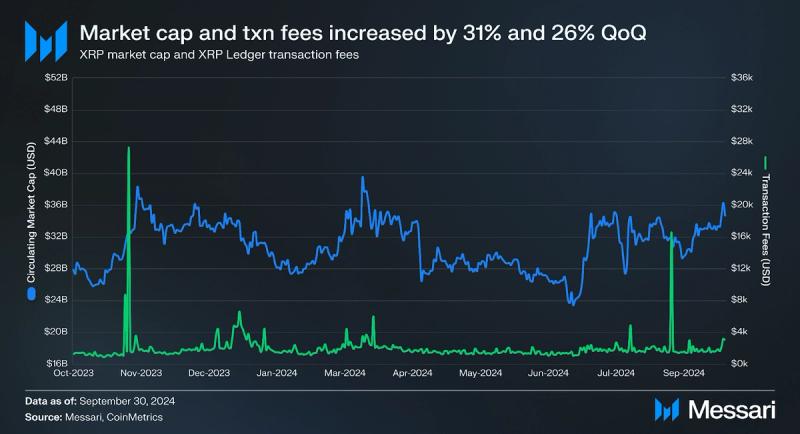
XRP’s QoQ market cap increase of 31% outpaced the overall crypto market which declined by roughly 3%. On an annual scale, XRP’s circulating market cap has increased 26% YoY. On the XRPL, transaction fees are burnt and not distributed to stakers like on many other networks. The burning of those fees still decreases the overall supply, adding value to the remaining XRP. In this way, transaction fees still represent a redistribution of wealth from transaction fee spenders to XRP holders.
Network Analysis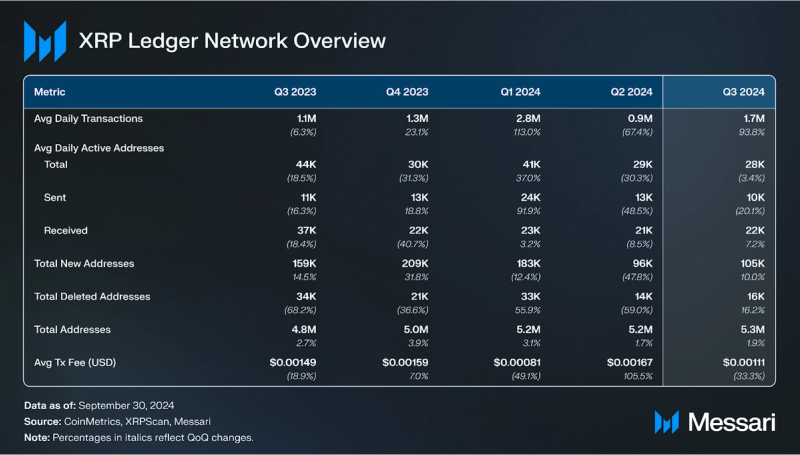
After a decline in all measured network metrics except total addresses last quarter, a number of metrics reversed that trend and grew in Q3. Chief among them, average daily transactions increased 94% QoQ to 1.7 million and total new addresses increased 10% to 105,000. However, the uptick was primarily driven by microtransactions (<1 XRP), which according to Ripple’s Q3 2024 report appeared to be part of a spam messaging campaign. On an annual scale, quarterly new addresses decreased by 34% from Q3 2023 to Q2 2024. Account creations and deletions are meaningful on the XRPL (unlike on most networks) as accounts require a 10 XRP deposit to be created, which can be reclaimed after deleting the account. As such, the XRPL’s account metrics are more reliable than other networks where account creations can easily be spammed/Sybiled at zero cost.
Total active addresses decreased by 3% QoQ. This overall decline was due to the 20% decrease QoQ in active addresses sent (i.e., unique senders) outpacing the 7% QoQ increase in active addresses received (i.e., unique receives).
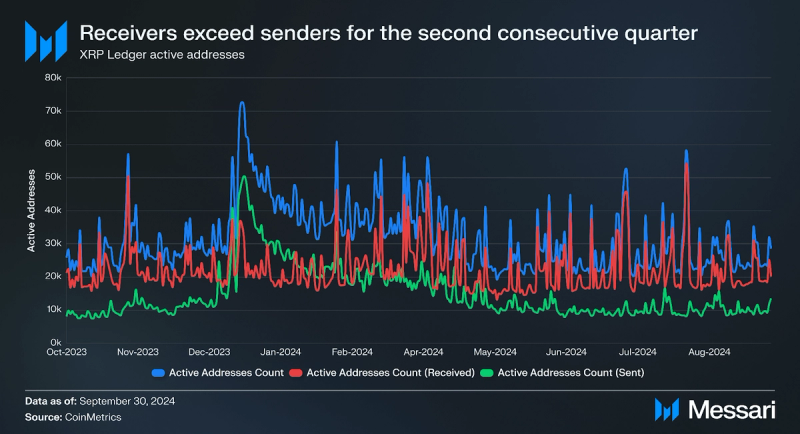
Addresses on the XRPL can contain destination tags, which enable a single address to receive and track XRP deposits for an arbitrary number of users. As a result, the number of daily active addresses is skewed downward, given that one account (e.g., a centralized exchange) could be responsible for a large number of users. It should be noted that a unique address is required for receiving tokens on most other networks, like ETH on Ethereum or BTC on Bitcoin.
For the second consecutive quarter active receiver addresses exceeded active sender addresses on the XRPL. The active recipient metric is determined by the number of addresses that receive a transfer or other transaction. When recipients outpace senders, it indicates that more previously inactive wallets are receiving tokens distributed by senders than there are senders distributing those tokens. One common reason for this dynamic is airdrops, which are a token distribution strategy to reward and engage community members. Airdrops are more practical on networks with low transaction fees, such as the XRPL, or networks that enable batch transactions.
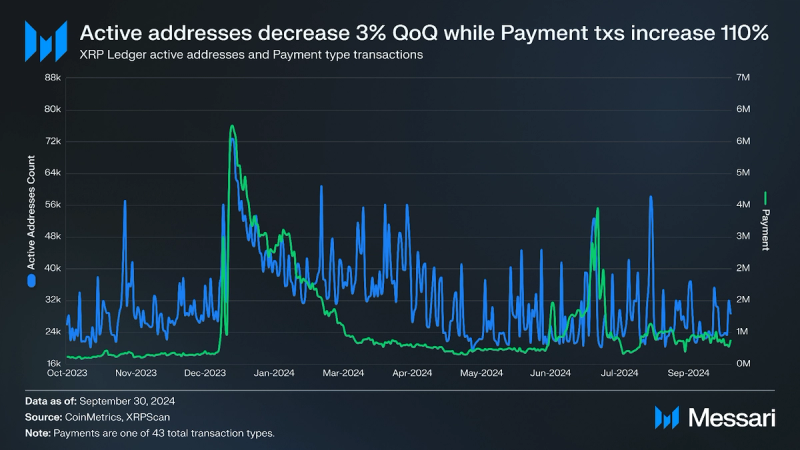
Payment transactions increased 110% QoQ after declining for two consecutive quarters following a large spike due to inscription activity beginning at the end of 2023. In contrast, total active addresses declined by 3% as mentioned above. Historically, for smaller activity spikes, the difference between the active recipient and sender addresses has been largely due to centralized exchanges and custodians using destination tags and sending Payment transactions. Centralized exchanges and custodians mostly use the Payment transaction type for deposits and withdrawals. As such, the Payment transaction type has consistently had more receiving addresses than sending addresses. In addition, users typically prefer creating wallets on centralized solutions for easy access to the initial XRP required to create a self-custody wallet. After acquiring their initial XRP, many users withdraw to their self-custody wallets, resulting in fewer active senders and many active receivers.
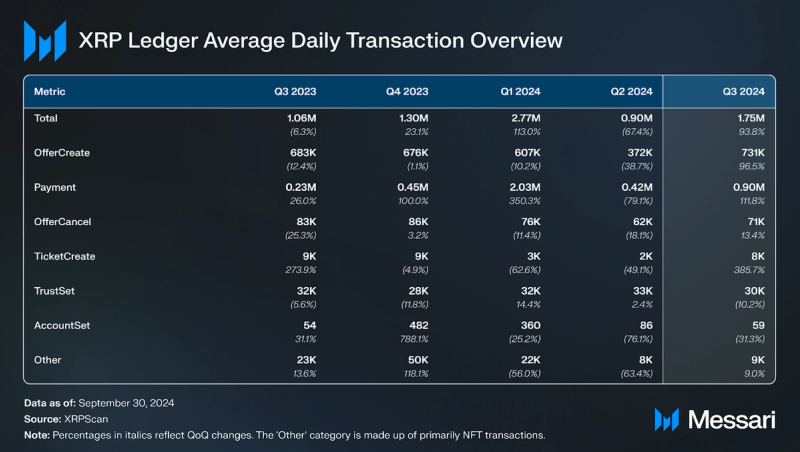
The total daily transactions metric includes 43 different transaction types, such as payments, escrow creations, NFT burns, and account deletions. Average total daily transactions decreased 94% QoQ from 900,000 per day to 1.75 million per day.
Prior to Q1 2024, OfferCreate, a transaction type that submits an order to exchange cryptoassets, has consistently represented the bulk of transactions. This transaction type only creates an “Order” on the order book and does not necessarily facilitate an exchange unless it completes an existing open Order. OfferCreate initiates a DEX limit order, and Offer objects represent bids/asks on the order book. Offers are consumed to process transactions such as Payment and OfferCancel (triggered manually or by expirations). If an Offer is only partially consumed by a transaction, a new Offer is created with the remainder of the original, similar to a UTXO. An Offer can be canceled by the OfferCancel transaction. Trust Lines are structures for holding tokens that protect accounts from being sent unwanted tokens, and the TrustSet transaction is used to open or close those Trust Lines.
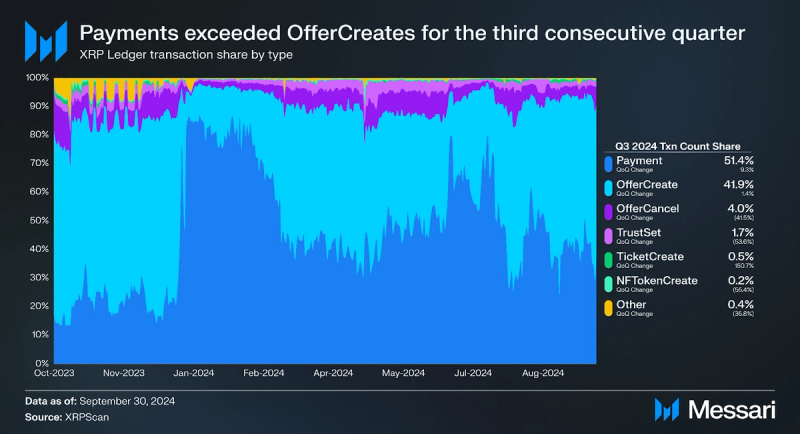
Payments exceeded OfferCreates for the third consecutive quarter with Payments and OfferCreates' share of the overall transaction count increasing 9% and 1% QoQ respectively. Prior to Q1 2024, OfferCreate was historically the most common transaction type.
Overall, average total daily transactions increased 94% QoQ from 0.90 million per day to 1.75 million per day. The “Other” category of transactions includes transaction types for NFTs, escrows, multisigs, setting signer keys, and more. These transaction types are covered in depth in the Ecosystem Overview section.
DEXCLOB
A built-in central limit order book (CLOB) processes exchanges on the XRPL for fungible tokens (also called Issued Currencies or simply tokens). This CLOB has been part of the XRPL since inception and comes with the benefit of fewer trust assumptions and consolidated liquidity, rather than the inherent vulnerabilities of smart contracts. The majority of transactions come from the native CLOB. Although there is only one CLOB, there are many marketplaces acting as gateways that facilitate access. Gateways, also known as marketplaces, all share liquidity and provide a viable user interface for the average user.
AMM
In addition to the existing CLOB, an automated market maker (AMM) was voted into the protocol in March of Q1, as detailed by the XLS-30 standard. AMMs function through liquidity pools that algorithmically price assets rather than creating offers of preset specifications. Liquidity pools allow holders to earn a share of trade fees on their tokens by offering them as liquidity. Importantly, orders can be partially routed through the AMM and partially through the CLOB, as both work together as part of the DEX.
In September, an amendment to better match trade sizes to improve swap rates on the AMM was activated. Additionally, in September, Hummingbot released its XRPL connector as part of Hummingbot 2.0, allowing for automated market-making and arbitrage strategies on the XRPL.
ServersNodes and validators, known as servers, all run the same client software: rippled. Over 55% of nodes have upgraded to V2.2.3 since its release in September of Q3. As of the end of Q3, the XRPL is supported by 621 nodes and 109 validators. Nodes increased from 602, and validators decreased from 119 since Q2.
XRPL servers participate in federated consensus as part of the XRPL’s Proof-of-Association (PoA) consensus mechanism. Validators do not stake tokens or receive financial rewards. Instead, the system is based on trust between nodes. Each node sets a list of trusted nodes, known as a unique node list (UNL). Additionally, the Negative UNL is a feature that adjusts servers' “effective UNLs” based on which validators are currently online and operational. The UNLModify transaction, which was called an average of 4.3 times per day in Q3, marks a change in the Negative UNL, indicating that a trusted validator has gone offline or come back online.
Ecosystem Analysis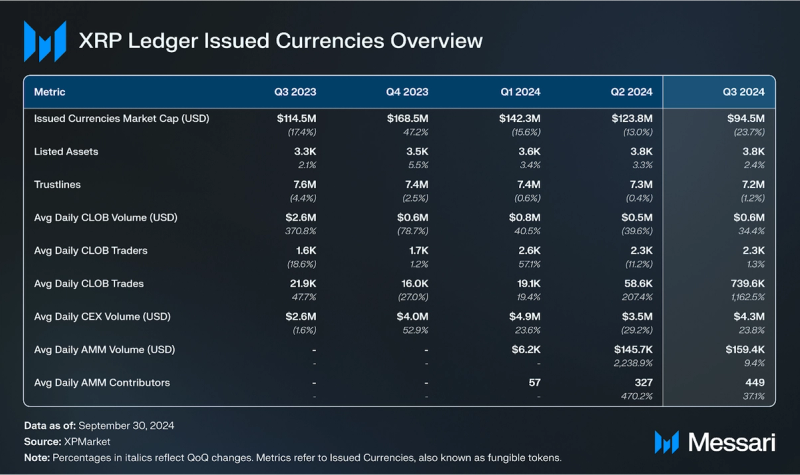
Although the XRPL’s ecosystem hosts many of the same features as programmable settlement networks — such as Ethereum, Solana, and Cardano — the XRPL does not natively support smart contracts. However, in September, Ripple, along with the broader XRP community, announced its intent to introduce native smart contracts on the XRPL via an upcoming XLS proposal. Smart contracts are intended to be permissionless and provide for easy customization of XRPL’s built-in features such as escrows, NFTs, authorized trustlines, payment channels, the DEX, and AMM.
Historically, arbitrary smart contracts have not been enabled on the base layer as a design choice to ensure maximum security, performance, and stability. Instead, ecosystem artifacts – such as a DEX and Issued Currencies – are natively built into the protocol. The XRPL supports multiple assets through tokens (also called Issued Currencies or IOUs). They are onchain representations of arbitrary currencies, commodities, units, etc.
DeFiThe total market cap of fungible tokens, known as Issued Currencies, decreased 24% QoQ to $95 million. There are more than 3,800 listed assets on the XRPL, but the top token, SOLO, accounted for 34% of the total market cap. Combined, the top four tokens accounted for 71% of the total market cap.
The top tokens on the XRPL by market cap at the close of Q3 were as follows:
- Sologenic (SOLO) had a market cap of $34.3 million and 228,000 holders. SOLO is primarily used to pay transaction fees on the Sologenic gateway.
- Bitstamp BTC (BTC) had a market cap of $12.5 million and 4,500 holders. Bitstamp BTC is a wrapped version of Bitcoin provided by Bitstamp.
- Gatehub Fifth ETH (ETH) had a market cap of $11.3 million and 26,000 holders. Gatehub fifth is a wrapped version of Ether provided by GateHub.
- Coreum (CORE) had $8.9 million in market cap and 71,000 holders. CORE is the native token of the Coreum sidechain, which was also developed by the Sologenic team.
Trust Lines are structures in the XRP Ledger for holding fungible tokens and enforce the XRPL’s rule that someone cannot be forced to hold a token they don’t want. As such, Trust Lines make metrics around token behavior on the XRPL more reliable. While an account’s first two trustlines are free, thereafter the XRPL requires a lockup of 2 XRP (owner reserve) for each object, such as an issued currency, that the address owns. A base reserve of 10 XRP is also required to create an address. These requirements make it expensive to enact a Sybil attack on XRPL metrics, such as the number of holders. For this reason, the number of holders is a reliable metric of a token’s adoption on the XRPL. The metric is especially relevant for fungible tokens, which have much higher supplies than NFTs.
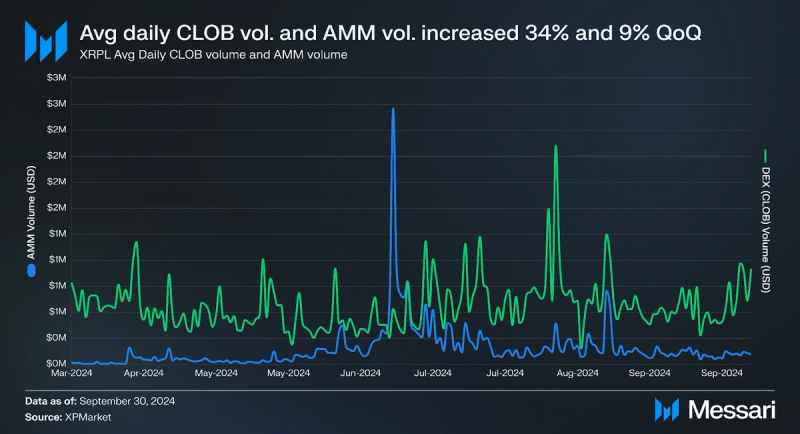
While the average daily CLOB volume of fungible Issued Currencies increased 34% QoQ to $640,000, the average daily amount of CLOB trades increased more than 1,110% to 740,000. Average daily CLOB traders increased 1% QoQ to 2,300. Sologenic is the leading DEX (i.e., the leading gateway to the native DEX) on the XRPL by volume of Issued Currencies exchanged. Other prominent DEXs (gateways) include XPMarket, MagneticX, and First Ledger, a Telegram trading bot developed by the team behind xrp.cafe.
After its launch in March, AMM volume eclipsed CLOB volume for six days in June and peaked at $2.5 million. Despite not reaching those daily highs in Q3, average daily AMM volume still increased 9% to about $160,000, reflecting increased consistent usage. All prominent DEXs (Sologenice, XP Market, MagneticX, First Ledger, etc), and newer platforms, such as Orchestra Finance and Moai Finance, have integrated.
Notably, XRP Ledger’s AMM design includes a mechanism that allows the liquidity providers of a respective liquidity pool to bid LP tokens for an auction slot, which grants a discount on trading fees for a 24-hour period. This mechanism is intended to incentivize the account holding the auction slot for a given liquidity pool to keep prices in balance with external markets. Liquidity on the AMM is shared across all DEXs (gateways), just like with the CLOB.
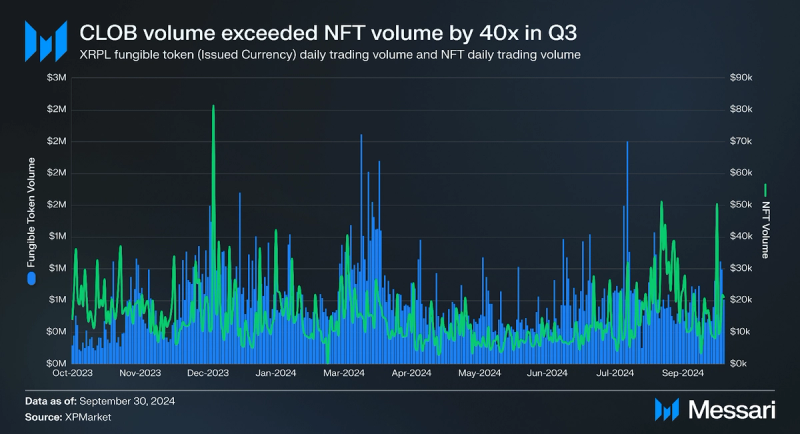
Stablecoins and wrapped tokens are popular on XRPL ranked by number of holders, relative to other tokens. Gatehub and Xaman (formerly Xumm) have worked together to offer a total of 14 digital assets on XRPL. The top stablecoins and wrapped tokens (also known as IOUs) on the XRPL at the close of Q3 were as follows:
- Bitstamp BTC: $12.5 million market cap and 4,500 holders
- Gatehub Fifth (ETH): $11.3 million market cap and 26,000 holders
- Gatehub USD: $3.4 million market cap and 20,000 holders
- Bitstamp USD: $2.0 million market cap and 7,000 holders
In April Ripple first announced plans to launch a USD-pegged stablecoin on both the XRPL and on Ethereum, using XRPL native functionality and ERC-20 token standards, respectively. The stablecoin will be backed entirely by U.S. dollar deposits, short-term U.S. treasuries, and “other cash equivalents," with monthly third-party attestations. The introduction of a trusted stablecoin in a novel execution environment has proven to be a massive liquidity event in many cases (e.g., Cardano’s iUSD in 2023), particularly as a desired pairing asset for AMMs.
Since then, Ripple has provided several additional updates regarding RLUSD. In August, Ripple announced that RLUSD is in private beta on both the XRPL and Ethereum and pending regulatory approval. In October, Ripple President Monica Long announced that RLUSD is “operationally ready,” and Ripple announced a number of exchange partners for the token and an RLUSD advisory board. Notably, RLUSD is issued under a New York Trust Company Charter to ensure stringent oversight and regulation.
Currently, stablecoins on XRPL have not seen the adoption of major stablecoins on other networks, such as USDT ($125 billion market cap) or USDC ($37 billion market cap).
Also in April, proposals were made to introduce a native lending protocol on XRPL (XLS-66), whereby users could lend and borrow supported assets, such as XRP, wBTC, and wETH using single-asset vaults (XLS-65). Unlike overcollateralized lending protocols like Aave, the protocol is intended to offer onchain fixed-term and rate loans via offchain underwriting, risk management, and an insurance fund — a model akin to that implemented by TrueFi on Ethereum. In September, a number of updates were made to both proposals including single-asset vaults holding assets directly, and both the vault and lending protocol supporting clawback and asset freezing for asset issuers with compliance and regulation requirements.
Axelar, a full-stack interoperability protocol (i.e., a crypto overlay network), integrated XRPL in Q1. It connected the XRPL ecosystem to the 60+ networks, including the Ethereum and Cosmos ecosystems. As the AMM grows, the Axelar connection makes it easier to source liquidity from many of the highest-TVL networks.
RWAsReal-world assets (RWAs) are being made available on XRPL in several ways. In August, OpenEden launched tokenized US Treasury bills (T-bill) on the XRPL, with Ripple committing to allocate $10 million to OpenEden’s TBILL tokens. Additionally, Archax and Ripple are developing a mechanism for financial institutions to tokenize RWAs onto the XRPL that is intended to bring hundreds of millions of dollars in RWAs to the XRPL over the next year. Zoniqx and Ripple are also working on bringing Zoniqx’s tokenization services to the XRPL. The clawback feature in particular would allow asset issuers to experiment with moving RWAs onchain while remaining compliant.
Last quarter, Meld Gold announced a partnership with Ripple to bring fungible gold and silver assets to the XRPL. Also Tiamonds, a tokenized diamond project whereby users can hold NFTs representing real-world diamonds, launched on the xrp.cafe marketplace.
Adjacent to RWAs, the XRPL has also been explored as a tool for other institutional products. Ripple is one of the leading companies developing technologies to leverage the XRPL for institutional and government use cases. The company is focused on utilizing XRP and the XRPL to drive its On-Demand Liquidity service, custody, and tokenization initiatives.
NFTs
On the XRPL, NFTs are built into the core protocol and do not require smart contracts for creation or transfers, like Issued Currencies (also known as native tokens). NFTs were standardized by XLS-20 in October 2022, bringing benefits such as royalties and anti-spam features. These features help users not only avoid unwanted tokens but also help them stay legally compliant by avoiding specific tokens and smart contracts that have been made illegal within specific regions.
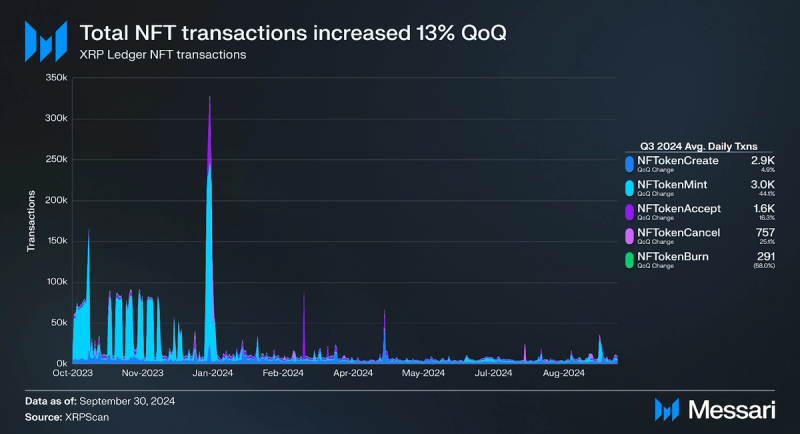
In Q3, NFT mint and burn transactions increased 93% and 148% respectively, while NFT create and accept offer transactions declined 13% and 8% respectively. In contrast, the amount of NFT cancel offer transactions remained flat QoQ.
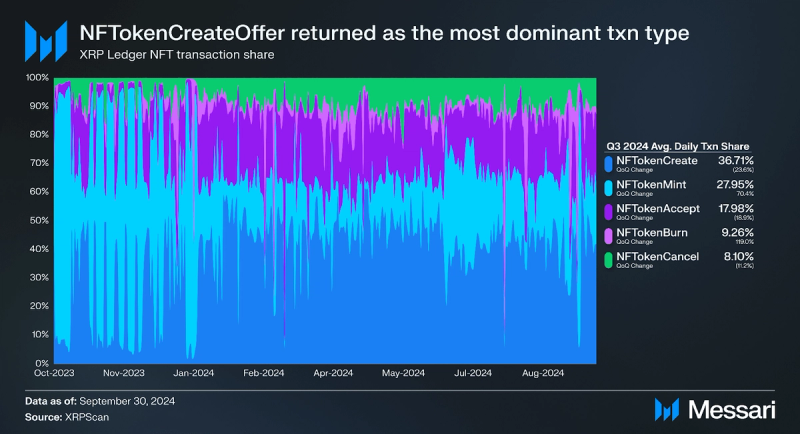
Massive spikes in mint activity drove NFTokenMint to surpass NFTokenCreateOffer as the most common NFT transaction type in Q4 2023 and Q1 2024. However, NFTokenCreateOffer was the dominant transaction type in both Q2 and Q3 2024. This reversal followed the trend of OfferCreate being the most dominant of all transaction types on XRPL. As of the end of Q3, 6.7 million total NFTs have been minted with the XLS-20 standard. Notably, over 3.4 million of those mints came in Q4 2023.
Notable NFT projects on XRPL include:
- Gaming NFTs such as Zerpmon, a Pokemon-esque game.
- Real-world solutions/assets such as Tiamonds tokenized diamonds or Xange’s carbon credits program.
Notably, last quarter xrp.cafe launched its automated NFT launchpad that allows anyone to launch an NFT collection on XRPL. XPMarket also features an NFT marketplace and auction mechanism.
SidechainsMultiple sidechains for the XRPL are either in development or were recently launched. To date, the XRPL has maintained minimized L1 complexity, offering increased programmability for both general and specific use cases on sidechains.
CoreumCoreum (CORE) is an enterprise-grade L1 focused on interoperability and scalability. Coreum runs a WASM VM and is secured by a Bonded Proof-of-Stake (BPoS) consensus mechanism. CORE is used for transaction fees, staking, and validator rewards on Coreum.
Coreum was built by the Sologenic team to service user needs that could not be efficiently managed on the XRPL. The network's initial focus is on providing security tokenization, such as tokenized stocks from the NYSE and synthetic assets. In March, Coreum completed an IBC integration, granting access to all IBC-connected networks such as Cosmos Hub, Ethereum, and BSC. This was followed by:
- Integration with Picasso Network in June for IBC interoperability with Solana.
- Integration with Band Protocol’s Band Oracle for bridging RWA’s to IBC-integrated chains.
- Coreum’s V4 upgrade in July, which introduced smart contract extensions to tokens, a clawback feature, and dynamic NFT data, among other updates.
Users can already transfer between Coreum and the XRPL via the noncustodial Sologenic bridge.
XRPL EVM SidechainLast quarter, the Ripple team announced XRPL EVM Sidechain as the official name for Peersyst’s EVM sidechain proposal to bring smart contracts to the XRPL ecosystem. The sidechain aims to grant the XRPL ecosystem access to EVM developers and functionality, with a general-purpose scope. The sidechain is being built on the Cosmos SDK, specifically evmOS, and connects to the XRPL through the XRPL-EVM bridge. The devnet is currently live and is creating blocks every ~3.9 seconds using the Comet BFT PoS consensus mechanism, a variant of Tendermint.
The latest version of Peersyst’s EVM sidechain was deployed on devnet V2 in Q2 2023. Dapps such as identity protocol XRPDomains were deployed on the testnet. Notable additions to the latest version include:
- Support for XRP, IOU, and ERC-20 token transfers via the bridge
- Proof-of-Authority consensus
- Smart contract verification on the block explorer
Cosmos IBC interoperability was enabled in May, allowing for tokens to be bridged from IBC-enabled chains to the XRPL. Additionally, the Ripple team announced in June that Axelar will replace the currently implemented bridge design proposed in the cross-chain bridges (XLS-38d) specification as the XRPL EVM Sidechain’s exclusive bridge. This will include sourcing the native gas token of the sidechain (eXRP) from the XRPL. In a follow-on announcement, Peersyst stated the XRPL EVM Sidechain would launch following Axelar integration “later this year.”
Root NetworkThe Root Network sidechain is a blockchain-based NFT system with a focus on UX and metaverse, run by Futureverse. The Root Network is live in alpha, along with its bridge to XRPL and Ethereum, which was upgraded in September to allow two-way bridging of any token between the XRPL and The Root Network.
Built from a Substrate fork, the Root Network uses XRP as the default gas token and has EVM support for smart contracts. The Root Network uses a delegated-Proof-of-Stake (dPoS) consensus mechanism (via the ROOT token). The protocol’s roadmap items are aligned with the XRPL, seeking to integrate the XLS-20 NFT standard and source liquidity from the XRPL DEX. Root Network also plans to offer users social recovery, management of assets, increased wallet flexibility, and a familiar Web2 experience through the account abstraction solution FuturePass.
HooksHooks is a feature developed by XRPL Labs to include smart contract-like functionality for the XRPL transactions. While Hooks are not Turing complete and do not enable arbitrary logic, they do allow conditions and triggers to be attached to transactions — similar to scripts on UTXO chains like Bitcoin and Cardano (pre-Alonzo). In particular, Hooks enable several programmability features, including the scheduling of payments, distributing a set percentage of funds to a creator for royalties, or imposing limits/restrictions on transactions for both volumes and counterparties. In July, the XRPL Labs team launched its latest testnet for Hooks written in JavaScript (JS), one of the most widely used programming languages.
GovernanceThe XRP Ledger (XRPL) uses an offchain governance process that allows community members and organizations to propose changes to the network. Users can submit proposals, otherwise known as Amendments, to the “XRPL-Standards” repository on the project’s GitHub. Block-producing validators on the network can then run versions of the XRPL source code that implement the proposed amendments. If 80.00% or more of the block-producing validators support the amended source code for two weeks, then it is implemented as the new source code for the network. Validators that do not support the amended source code are then blocked from contributing to consensus until they update to the newly changed version.
Recent notable approved amendments include:
- Decentralized Identity (XLS-40): Enabled at the end of October, Decentralized Identity (DID) enables verifiable, self-sovereign digital identities on the XRPL for use cases in compliance, access control, digital signature, and secure transactions.
- Price Oracles (XLS-47): Enabled in November, this amendment brings price oracles to the XRPL for pricing wrapped/bridged assets. Anyone can now call OracleSet to create or update an existing price oracle or OracleDelete to delete an existing price oracle. Oracle providers Band Protocol and DIA previously integrated with the XRPL in July. With oracles enabled, the get aggregate price API call aggregates the price of an asset from all live oracles while discarding any outliers.
Additionally, some notable proposals made in the third quarter of 2024 include:
- Multi-Purpose Tokens (XLS-33): A proposal to introduce the multi-purpose token standard (MPT). MPT enables support for metadata to store parameters regarding an issued RWA, such as the maturity date of a tokenized bond. Coupled with the clawback function enabled in Q1 2024, the XRPL is continuing to add functionality to give regulatorily compliant token issuers more control.
- AMM Clawback (XLS-74): A proposal to support clawback functionality on the AMM. Clawback functionality is needed for regulated tokens such as RLUSD to have fully compliant AMM liquidity pools.
- Simulating Transaction Execution (XLS-69): Proposes a new simulate API method for developers to safely experiment with transactions for testing and refinement.
- Permissioned Domains (XLS-80): This proposal introduced permissioned domains, which can only be accessed by users based on their Decentralized Identity (DID). Notably, this amendment builds on Onchain Credential Support (XLS-70), which was first proposed last quarter. XLS-70 would add support for creating, accepting, and deleting credentials on XRPL as part of identity management first introduced in Decentralized Identity (XLS-40), which was implemented at the end of October.
In September, it was announced that entities supporting the XRPL, including Ripple, InFTF (formerly XRPL Foundation), XRPL Labs (and Xaman), XRPL Commons, and other members of the XRP community, began discussing the establishment of a new XRP Ledger Foundation. Additionally, XRPL Foundation assets were agreed to be transferred to a new independent foundation set to feature a governance structure that includes developers, users, academics, validators, and infrastructure providers. As part of the transition process, the existing XRPL Foundation team established a new Inclusive Financial Technology Foundation (InFTF) with a future foundation entity to be incorporated.
Other Notable UpdatesA number of additional integrations, partnerships, and upgrades also took place in the third quarter, enhancing the XRPL ecosystem and the network’s overall utility.
- Peersyst launched XRPL Snap integrating the Metamask wallet with the XRPL.
- Immersive announced it is working with Xahau Network to bring a self-custodial onchain Mastercard credit card to the XRPL.
- Futureverse, an AI and metaverse technology and content company announced plans to integrate Ripple Custody to securely custody its digital assets.
- Ripple announced the launch of Ripple Payments in Brazil with Mercado Bitcoin, Latin America’s largest cryptocurrency exchange as its first customer. Additionally, Ripple announced a partnership with Fenasbac in Brazil to support development of fintech on the XRPL via the Next accelerator program.
- Ripple introduced a “Try it” feature for the Ripple Payments API for developers to test API requests in real-time without logging in or using real funds.
- XRPScan announced beta availability of the XRPL advanced search engine, which allows users to search and filter by more than 100 different transaction fields.
- Girin Labs, an infrastructure developer on the XRPL announced it had received funding from Ripple’s XRP Ledger Japan and Korea Fund. Girin Labs is developing the Girin Wallet for XRPL and Lotus Protocol, a liquid staking token and lending protocol on The Root Network XRPL sidechain.
In September, the XRPL grants program introduced artificial intelligence (AI) as a new funding track. Previously in May, Ripple announced changes to the XRPL grants program including a revised screening criteria for applicants, rolling applications, the inclusion of additional XRPL-based project developers in the screening process, office hours for potential and rejected applicants to receive feedback, and launched a feedback survey for applicants. Additionally, the XRPL Accelerator program has two tracks in 2024: the Launch Program for early-stage projects and the Scale Program for later-stage projects. In July, the first Launch Program cohort was announced, while the second Scale Program cohort began in September.
Also in July, Ripple announced a partnership with the Dubai International Financial Centre (DIFC), to connect developers with the DIFC’s Innovation Hub, while in August a partnership with APAC DAO to support developers building on the XRP Ledger in Southeast Asia was announced. Other community support programs include XRPL Hackathons and the Aquarium Residency for developers offered by XRPL Commons. The RippleX Bug Bounty Program also pays bounties to individuals or groups that identify and report bugs in the rippled, xrpl.js, xrpl-py, and xrpl4j repositories.
Closing SummaryVolume for XRPL’s native CLOB and the AMM (in its second full quarter of availability) increased by 34% and 9% QoQ respectively. Likewise, average daily transactions increased 94% QoQ to 1.7 million and total new addresses increased 10% to 105,000. However, the uptick was primarily driven by microtransactions (<1 XRP), which according to Ripple’s Q3 2024 report appeared to be part of a spam messaging campaign.
Key amendments were also enabled in the third quarter introducing decentralized identity, which enables verifiable digital identities, and price oracles for pricing wrapped/bridged assets. Additionally, a number of important updates and announcements were made. Since August Ripple’s USD-pegged stablecoin RLUSD has been in private beta on both the XRPL and Ethereum while it is pending regulatory approval. Additionally, Ripple and the broader XRP community plan to introduce native smart contracts on the XRPL, while a native lending protocol is in development for users to lend and borrow supported assets such as XRP, wBTC, and wETH using single-asset vaults. In the quarters ahead, the XRPL remains primed for increased activity as these pending upgrades are likely to attract additional users once implemented.
- Home
- About Us
- Write For Us / Submit Content
- Advertising And Affiliates
- Feeds And Syndication
- Contact Us
- Login
- Privacy
All Rights Reserved. Copyright , Central Coast Communications, Inc.